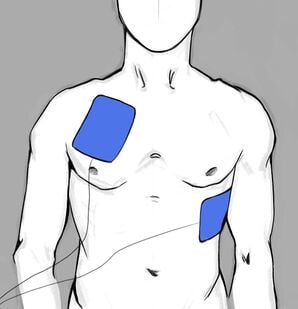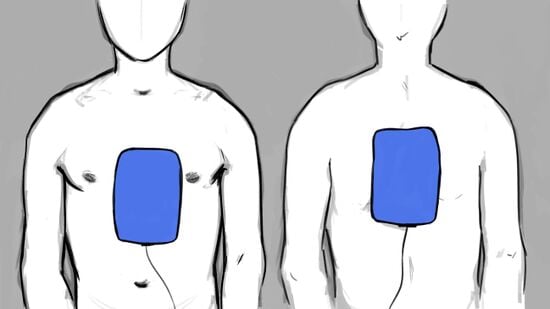When performing CPR on a pulseless adult or a non-breathing child or infant, an AED should be applied as soon as it is available.[1]
Perform the following steps without interruption of CPR:
- Turn on the AED and follow the visual and/or audio prompts from the machine.
- Open the person's shirt and wipe his or her bare chest dry. If the person is wearing any medication patches, you should use a gloved hand or other protective barrier on your hand to remove the patches before wiping the person's chest.
- Plug in the AED pads, remove the adhesive backing, and place the pads in the indicated locations on the patient's right upper chest and left lower ribcage for an adult or large child (Fig. 1) or in the anterior/posterior positions for a small child or infant (Fig. 2).
- Tell everyone to "stand clear" and make sure no one is touching the person.
- Push the "analyze" button (some models start analysis automatically) and allow the AED to analyze the person's heart rhythm.
- If the AED recommends that you deliver a shock to the person, it can take some time to charge. Continue chest compressions while charging.
- Once charged, tell everyone to "stand clear" - make sure that no one, including you, is touching the person while the shock is delivered automatically. For some models which do not auto deliver the shock, once the AED is charged and the patient is clear, press the "shock" button.
Restart CPR immediately after the shock was delivered, or if no shock was advised. Perform 2 minutes (about 5 cycles) of CPR and continue to follow the AED's prompts. If you notice obvious signs of life, discontinue CPR and monitor breathing for any changes in condition.
If ALS is not arriving on the scene, most local protocols advise transporting the patient when one of the following occurs:
- The patient regains a pulse
- Six to nine shocks have been delivered without Return of Spontaneous Circulation (ROSC)
- The AED gives three consecutive messages (separated by 2 minutes of CPR) that no shock is advised.
Your local protocol always takes precedence over this general guideline.
An AED can be used on children and infants and should be used as early as possible for the best chance of improving survival. Check the AED when it arrives at the scene. Pediatric pads should be used if the person is less than eight years old. Standard (adult) pads may be used if pediatric pads are not available. If using standard (adult) pads, do not let the pads touch. For infants less than a year old, a manual defibrillator should be used if available. If a manual defibrillator is not available, an AED may be used. Some AEDs have a switch that can be set to deliver a pediatric shock. If available, turn the switch on when using on children younger than eight years old. If the AED cannot deliver a pediatric shock, an adult shock should be given. It is important to remember an electric shock may be the cure for a fatal heart rhythm.


Tips and Tricks[edit | edit source]
- When placing the pads, if there is excessive hair, use a razor of second pair of pads to remove the hair. This allows for much greater contact with the patient's skin and increased chances of successful defibrillation.
References[edit | edit source]
- ↑ CITATION PENDING